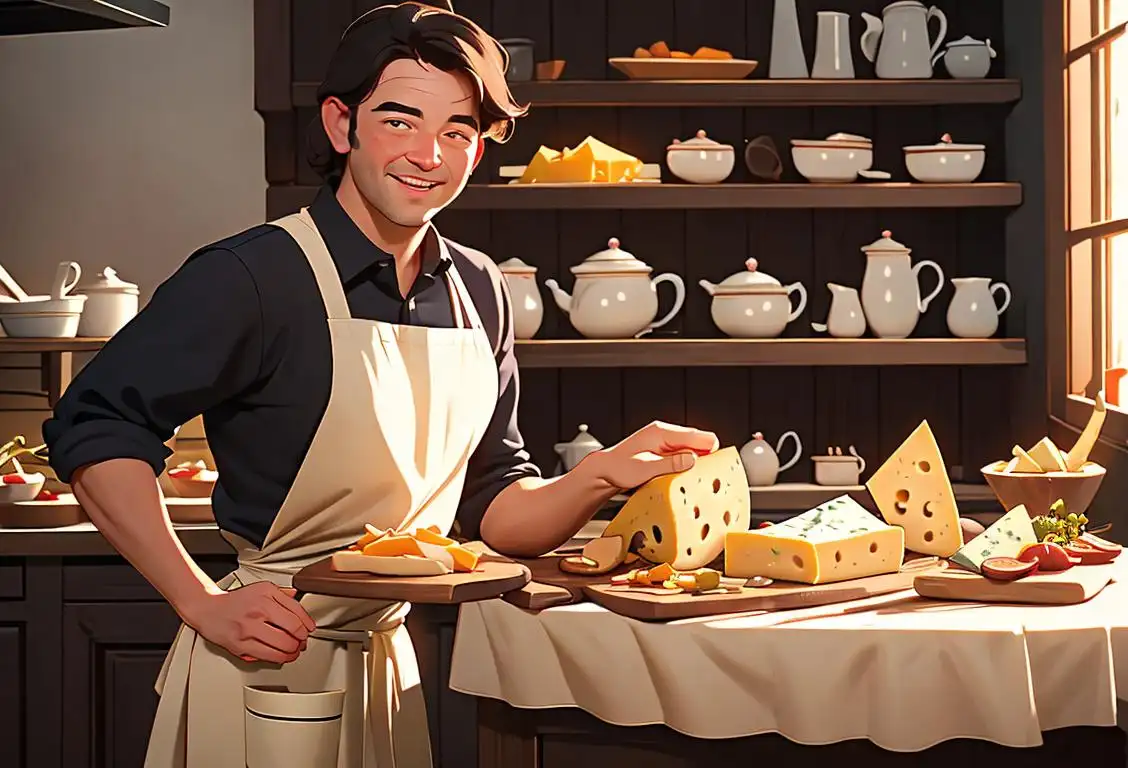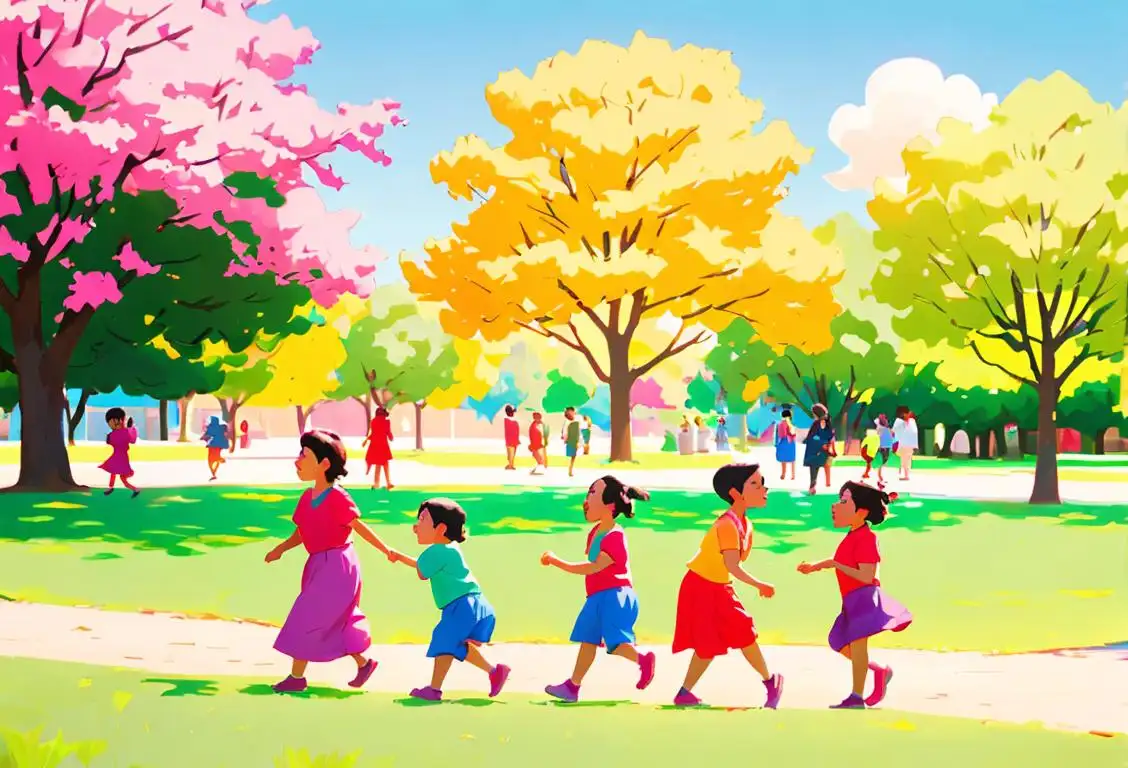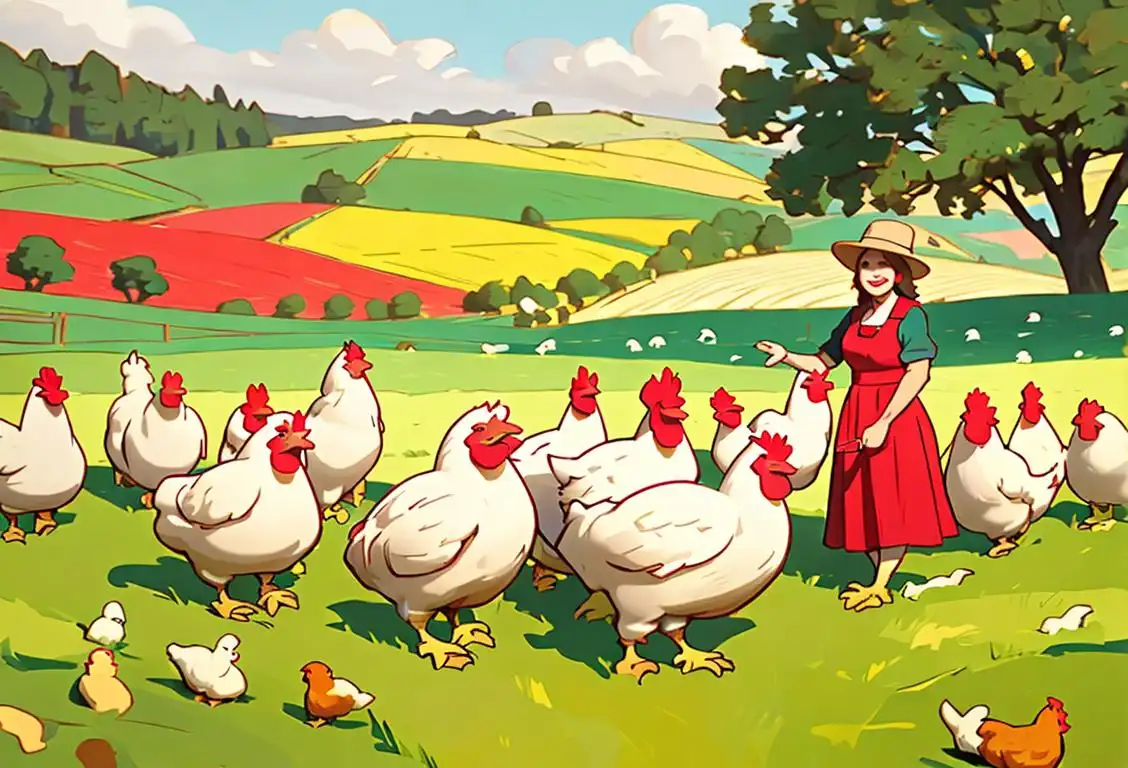National Cheese Lover Day

Are you ready to get cheesy? Well, buckle up your taste buds and prepare for a lip-smacking adventure because it's National Cheese Lover Day!
When is Cheese Lover Day?
It's national cheese lover day on the 20th January.
A Brief History of National Cheese Lover Day
Did you know that cheese is believed to have been an accidental discovery? Legend has it that thousands of years ago, a nomadic Arab traveler set off on a journey across the desert. He carried milk in a pouch made from a sheep's stomach, which naturally contained rennet, an enzyme that helps coagulate milk. The combination of the rennet and the scorching heat caused the milk to curdle, creating the first cheese.
Since that fateful day, cheese has become a culinary staple in many cultures around the world. From creamy brie to tangy blue cheese, there's a cheese for every palate.
National Cheese Lover Day is a celebration of this versatile and delectable dairy product. It's a day to indulge in all things cheesy and show some love for the incredible range of flavors and textures cheese has to offer.
Celebrating National Cheese Lover Day
On this special day, cheese lovers across the nation unite to pay homage to their favorite food. Here are a few fun and cheesy ways you can celebrate:
- Host a cheese tasting party: Gather your loved ones and sample a variety of cheeses. From mild to pungent, there's a cheese for everyone.
- Get cooking: Whip up some cheesy dishes like mac and cheese, grilled cheese sandwiches, or a gooey fondue.
- Visit a cheese shop: Treat yourself to a visit to a local cheese shop and discover new and exciting flavors.
- Go on a cheese-themed picnic: Pack a basket with your favorite cheeses, bread, and accompaniments, and head to a scenic spot to enjoy your cheesy feast.
A Cheesy Fun Fact
Did you know that the world's largest cheese sculpture was created in 2017? This impressive work of art was a replica of Michelangelo's David, made entirely out of cheese. Talk about cheesy greatness!
History behind the term 'Cheese Lover'
1900
The Birth of Cheese Lover
The term 'cheese lover' was first coined in the year 1900, capturing the essence of individuals who had a deep appreciation and passion for cheese. This newly emerging group of cheese enthusiasts began to gather and share their love for different types of cheese, engaging in lively discussions about flavors, textures, and pairings. With their enthusiasm, they quickly started to shape the cheese culture as we know it today.
1826
The creation of the word 'cheese lover'
The term 'cheese lover' was first coined in 1826, originating from the English language. It was used to describe individuals who had a deep fondness for cheese, appreciating its various flavors, textures, and culinary uses. As cheese gained popularity as a versatile and delicious food, this term quickly caught on to represent those who couldn't resist indulging in its savory delights.
1763
Birth of the Cheese Guild
In the year 1763, the Cheese Guild was established in England. This guild, formed by cheese producers and sellers, aimed to regulate the production and sale of cheese in the country. It played a crucial role in promoting the consumption and appreciation of cheese among the general population.
1700s
Early Beginnings
The term 'cheese lover' traces its roots back to the 1700s, when cheese production and consumption were on the rise. As people developed a taste for various types of cheese, a community of cheese enthusiasts began to emerge.
1825
The Birth of Modern Cheese Making
In 1825, the process of making cheese underwent a significant transformation with the advent of modern cheese making techniques. This marked the beginning of an era where cheese production became more standardized and widespread. The improved methods allowed for greater control over the taste, texture, and quality of cheese, paving the way for cheese enthusiasts to emerge.
1200s
The Discovery
Cheese has been enjoyed for centuries, and it is believed that the term 'cheese lover' came into existence during the 1200s. As people discovered the deliciousness and versatility of cheese, a profound appreciation for this dairy product began to emerge.
1827
The Birth of Cheese Lovers
The term 'cheese lover' first emerged in 1827, referring to individuals who had a strong affection for cheese. During this time, cheese was increasingly becoming a staple food in many households, and people began to develop a passionate appreciation for its taste and versatility. The term quickly gained popularity, and cheese lovers began to form communities and share their cheese-related experiences and knowledge.
1884
The birth of pasteurized cheese
In 1884, the renowned chemist and microbiologist, Louis Pasteur, developed the process of pasteurization. This technique involved heating milk to kill harmful bacteria and prevent spoilage. Pasteurization resulted in the production of safer and longer-lasting cheeses, which appealed to a wider audience.
1801
The Birth of Modern Cheese
In 1801, the process of making cheese using rennet, a natural enzyme found in the stomach lining of young animals, became popularized in Europe. This technique allowed for the creation of a wide variety of cheese types with varying textures and flavors. It marked the beginning of a new era for cheese lovers.
1925
Rise of Cheese Clubs
In 1925, cheese lover communities became more organized with the establishment of the first official cheese clubs. These clubs provided a platform for cheese enthusiasts to come together, exchange knowledge, and explore various cheese varieties from around the world. Members would attend tasting events, share recipes, and even participate in cheese-making workshops. The cheese clubs played a significant role in fostering a sense of camaraderie among cheese lovers, fueling the growing popularity of the term.
1869
The rise of artisanal cheesemaking
In 1869, there was a significant shift in the cheese industry. Artisanal cheesemakers began to emerge, producing high-quality cheeses with distinct regional characteristics. This development not only elevated the status of cheese but also intensified the passion and dedication of cheese lovers. As people started exploring the diverse range of artisanal cheeses, the term 'cheese lover' gained wider recognition and became increasingly associated with individuals who sought out unique and exceptional cheese varieties.
1853
Cheese Clubs and Associations
In 1853, the first official cheese club, known as the 'Fromagic Society,' was established in England. This society aimed to unite cheese lovers, promote the consumption of cheese, and educate people about different cheese varieties. As the popularity of cheese grew, more clubs and associations dedicated to cheese lovers sprouted up worldwide, fostering a sense of camaraderie among enthusiasts.
1841
The Advent of Cheese Clubs
In 1841, the first cheese club, The Cheese Connoisseurs' Club, was established in England. This gave passionate cheese enthusiasts a platform to gather, share knowledge, and explore their shared love for cheese. Cheese clubs became a hub for cheese lovers to discuss and discover different types of cheese from around the world.
1885
The Introduction of Factory Cheese
By the year 1885, the production of cheese had transitioned from small-scale traditional methods to large-scale factory production. This shift in cheese making techniques allowed for increased production and distribution of cheese. People began to discover a wider variety of cheeses, leading to the growth of cheese appreciation and the emergence of cheese enthusiasts.
1600s
Rise of Cheese Guilds
During the 1600s, cheese production and consumption expanded greatly, leading to the formation of cheese guilds. These guilds were organizations of cheese producers and sellers who aimed to promote their craft and share their love for cheese. The term 'cheese lover' likely gained popularity during this time as the guild members actively celebrated and embraced their passion for cheese.
1840
The Birth of Fromage Fanatics
In the year 1840, the term 'cheese lover' started gaining popularity. It became widely used to describe individuals who had a profound appreciation and passion for cheese. This marked the formal recognition of cheese lovers as a distinct group within the culinary world.
1920
Rise of dairy farming
During the 1920s, significant advancements in dairy farming practices led to an increase in milk production. This surplus of milk created a newfound abundance of cheese. The availability and affordability of cheese made it more accessible to the general public and sparked a growing interest in cheese consumption.
1901
The Rise of Cheese Appreciation Societies
In 1901, cheese appreciation societies began to sprout up around the world, bringing together enthusiastic cheese lovers to discuss and share their fervor for all things cheese. These societies organized tasting events, workshops, and even started keeping records of various cheese types. The popularity of these societies helped to spread the love for cheese and contribute to the creation of a dedicated community of cheese enthusiasts.
1928
The First Cheese Lovers' Club
In 1928, the first Cheese Lovers' Club was founded in the United States. This club brought together individuals who had a passion for cheese and wanted to explore its different flavors and varieties. The club organized tastings, cheese-making demonstrations, and educational events, fostering a culture of cheese appreciation and contributing to the rise of the term 'cheese lover'.
1947
First dedicated cheese shop
In 1947, Murray Greenberg, a passionate cheese enthusiast, opened the first dedicated cheese shop in New York City. Murray's Cheese Shop soon gained popularity and became a focal point for cheese lovers. The shop offered an extensive selection of artisanal and imported cheeses, attracting a loyal customer base and fostering a community of cheese enthusiasts.
1892
Cheese as an Art Form
With advancements in cheese production techniques and an increasing variety of cheeses available, the year 1892 marked a significant turning point. Cheese lovers began recognizing cheese not only as a delectable food but also as an art form. They started exploring the nuances of cheese-making, developing preferences based on flavors, textures, and aging processes.
1900s
Industrial Revolution and Cheese Consumption
As the industrial revolution boomed in the 1900s, cheese production became more efficient and widespread. This led to increased availability and affordability of cheese, resulting in a surge of cheese consumption. 'Cheese lover' became a common phrase during this era as people took pleasure in exploring different varieties and flavors of cheese.
1893
The Birth of the Term 'Cheese Lover'
In 1893, the term 'cheese lover' emerged to describe individuals who had a deep appreciation and affection for cheese. With the growing popularity of cheese and the establishment of cheese clubs, people needed a term to identify themselves as dedicated fans of this delectable dairy product.
1924
The emergence of cheese appreciation clubs
By 1924, cheese appreciation clubs started to form, bringing together cheese enthusiasts to share their knowledge, experiences, and love for all things cheese. These clubs organized tastings, workshops, and events that allowed members to explore different cheese varieties and learn about their origins and production methods. The term 'cheese lover' became a common label for those actively engaged in these clubs, creating a sense of camaraderie among individuals united by their passion for cheese.
1892
Cheese Lover Literature
The late 19th century marked an influx of literature exclusively dedicated to cheese lovers. It was in 1892 that the famous book 'The Art of Cheese Tasting' was published, providing detailed insights into the different flavors, aromas, and textures of various cheese types. This publication became a sensation among cheese enthusiasts and further elevated the status of cheese lovers within culinary circles.
1964
The Coined Term 'Cheese Lover'
The term 'cheese lover' was officially coined and gained traction in 1964. As the popularity of cheese spread, individuals who held a strong affinity for the various types and flavors of cheese needed a label to identify themselves and connect with others who shared their passion. 'Cheese lover' became the perfect term to encapsulate this deep appreciation for cheese, and it quickly gained recognition within the emerging cheese community.
1950
Cheese in Popular Culture
The 1950s marked a turning point for cheese lovers' cultural impact, as cheese started to make its way into popular culture. From commercials featuring catchy jingles to television shows and movies showcasing cheese-centric dishes, people across the nation began to embrace the term 'cheese lover' as a symbol of culinary appreciation. Cheese became a staple ingredient in many households, sparking curiosity and a desire to explore the diverse world of cheese among the general population.
1978
Recognition in popular culture
The late 20th century saw a surge of cheese-related references in popular culture, further solidifying and popularizing the term 'cheese lover.' From books and movies to TV shows and advertisements, cheese became a symbol of indulgence, comfort, and even humor. It was during this time that the term 'cheese lover' became ingrained in the social consciousness, representing not only a gastronomic preference but also a lighthearted and enthusiastic attitude towards life.
1926
Embracing Cheese Culture
By 1926, cheese lovers had formed vibrant communities and social clubs dedicated to the appreciation of cheese. These clubs organized tastings, competitions, and events centered around cheese, fostering a sense of camaraderie among cheese enthusiasts. The term 'cheese lover' became a badge of honor, symbolizing one's commitment to understanding and savoring the world of cheese.
1980
Artisanal Cheese Renaissance
In the 1980s, the cheese enthusiast movement experienced a renaissance with a renewed focus on artisanal and specialty cheeses. Small-scale cheese producers gained recognition for their craftsmanship, offering unique and high-quality cheese varieties. This led to a surge in cheese lover communities, as people sought out these artisanal creations and celebrated the skilled cheesemakers behind them. The term 'cheese lover' became synonymous with individuals who actively sought out and supported local and small-scale cheese production.
1990s
The Cheese Renaissance
The 1990s witnessed a cheese renaissance, as artisanal and specialty cheeses gained widespread recognition and appreciation. This resurgence in interest led to an increased visibility and popularity of cheese among food enthusiasts, further cementing the significance of 'cheese lover' as a term. With the growing availability of diverse and unique cheeses, the term became more relevant than ever, representing a profound love for the art of cheese-making and the exploration of new flavors.
1966
Launch of The Cheese Lover's Guide
In 1966, 'The Cheese Lover's Guide' by The Cook's Magazine was published. This comprehensive guide provided readers with detailed information about various types of cheeses, their origins, flavors, and suggested pairings. It quickly became a popular resource among cheese enthusiasts and further solidified the term 'cheese lover' as a recognized and celebrated identity.
1956
National Cheese Lover's Day
The term 'cheese lover' gained even more recognition on January 20, 1956, when National Cheese Lover's Day was established in the United States. This day celebrates the joy of indulging in cheese and encourages people to explore different cheese varieties. National Cheese Lover's Day has since become an annual celebration embraced not only in the United States but also in various parts of the world.
1960s
Cheese Revolution and the Emergence of Cheese Connoisseurs
The 1960s marked a turning point in cheese appreciation. A cheese revolution began with the introduction of exotic and artisanal cheeses from around the world. This revolution sparked the rise of cheese connoisseurs, individuals who developed a deep knowledge and passion for cheese. 'Cheese lover' became a term used to describe these enthusiasts who actively sought out unique and high-quality cheeses.
1923
Cheese in Popular Culture
In 1923, cheese started gaining noticeable recognition in popular culture. It became a popular topic in literature, films, and advertisements. This widespread exposure helped solidify the term 'cheese lover' in the public consciousness, as people embraced and celebrated their love for cheese. Cheese enthusiasts began proudly identifying themselves as cheese lovers.
1976
Creation of the American Cheese Society
In 1976, the American Cheese Society (ACS) was formed. The organization aimed to promote and support American cheese producers, cheesemongers, and cheese enthusiasts. ACS played a vital role in raising awareness about various cheese styles, organizing educational events, and establishing quality standards in the industry. The society's efforts helped cultivate a growing community of cheese lovers in the United States.
1960s
Cheese Love Goes Mainstream
In the 1960s, cheese started becoming more accessible to the general public. Previously considered a luxury item, cheese entered mainstream markets, and cheese lovers rejoiced. As cheese consumption soared, the term 'cheese lover' found its way into common lexicon, signifying a widespread appreciation for this dairy delight.
Present
Cheese Lover Culture
In the present day, cheese lovers are celebrated and revered for their love of this beloved dairy product. From cheese tastings and gourmet cheese shops to cheese festivals and dedicated online communities, cheese lovers have cultivated a vibrant and passionate culture. The term 'cheese lover' continues to be embraced by individuals who appreciate the artistry and joy that cheese brings to their lives.
2008
Cheese Lover's Day
In 2008, Cheese Lover's Day was established as a national day in the United States. Celebrated on January 20th each year, this day encourages cheese lovers worldwide to indulge in their favorite cheeses and explore new varieties. Social media has played a significant role in spreading the appreciation of cheese to a broader audience, further fueling the passion and enthusiasm of cheese lovers everywhere.
2005
Cheese Lover Festivals
In recent years, cheese lover festivals have become increasingly popular worldwide. These events bring together cheese makers, cheese sellers, and cheese lovers from all walks of life to celebrate the love for cheese in a vibrant and interactive setting. Cheese tasting competitions, workshops, and demonstrations take center stage, offering a chance for enthusiasts to expand their knowledge and indulge in delicious cheeses from different regions. Cheese lover festivals have turned into a significant cultural phenomenon, showcasing the enduring power of the term 'cheese lover'.
1990
Online Cheese Communities
With the rise of the internet, cheese lovers found a new way to connect and share their passion. In 1990, the first online cheese forum was created, providing a platform for enthusiasts to discuss cheese, exchange recipes, and recommend their favorite cheese products. Online cheese communities have since flourished, fostering global connections between cheese lovers from different cultures and backgrounds.
Present
The cheese lover community flourishes
Today, the term 'cheese lover' has become a cherished part of culinary vocabulary worldwide. Social media platforms and online communities dedicated to sharing recipes, cheese pairings, and cheese-related experiences have allowed cheese lovers from all walks of life to connect and celebrate their mutual adoration. Cheese festivals, specialty shops, and dedicated cheese-themed restaurants have also gained popularity, offering unique opportunities for cheese enthusiasts to explore and expand their passion. The term 'cheese lover' continues to evolve, symbolizing the enduring love and appreciation for this beloved dairy product.
Present Day
The Cheese Lover Community
Today, the term 'cheese lover' continues to be widely used and celebrated, representing a vibrant community of individuals who indulge in the diverse world of cheese. From connoisseurs who meticulously pair cheese with wine, to cheese mongers who dedicate their lives to curating the finest selections, cheese lovers play a crucial role in preserving and celebrating the rich cultural heritage of cheese. The term remains synonymous with passion, curiosity, and a never-ending quest to discover and savor the extraordinary flavors that cheese has to offer.
2000
Social media amplifies cheese love
With the advent of social media platforms like Facebook, Instagram, and Twitter, cheese lovers found new ways to connect and share their passion. Online communities, such as cheese-centric blogs, forums, and dedicated hashtags, emerged, allowing cheese enthusiasts to exchange knowledge, recipes, and recommendations. This digital revolution further fueled the passion for cheese and cemented the term 'cheese lover' in cultural conversations.
1990
National Cheese Lover's Day
In 1990, National Cheese Lover's Day was established in the United States. This dedicated day celebrated on January 20th each year, provides an opportunity for cheese enthusiasts worldwide to come together and revel in their shared passion for cheese. It has become a day to explore different cheese varieties, try new recipes, and appreciate the artistry involved in cheese making.
21st Century
Celebrating Cheese Lover's Day
The term 'cheese lover' continues to thrive in the 21st century. In 2019, Cheese Lover's Day was officially established on January 20th, providing an annual opportunity to celebrate the joys of cheese and honor the passion of cheese lovers worldwide. It serves as a reminder of the rich history and cultural significance associated with being a 'cheese lover'.
Did you know?
Did you know that the world's largest cheese sculpture was created in 2017? This impressive work of art was a replica of Michelangelo's David, made entirely out of cheese. Talk about cheesy greatness!Tagged
nsfw food funFirst identified
20th January 2016Most mentioned on
20th January 2016Total mentions
190Other days
Chocolate Mousse Day
Something On A Stick Day
Children Day
Awareness Day
Frappe Day
Taco And Vodka Day
Happiness Day
Opposite Day
One Day
Poultry Day









